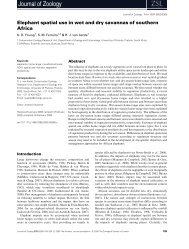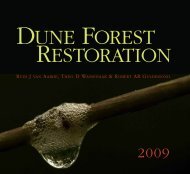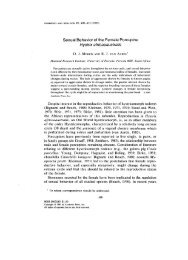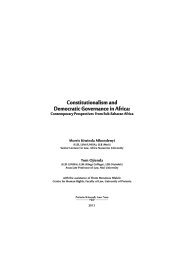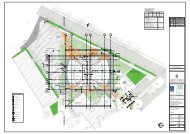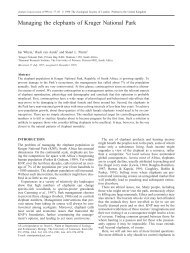Neighbourhood renewal in Cape Town's inner city: Is it gentrification?
Neighbourhood renewal in Cape Town's inner city: Is it gentrification?
Neighbourhood renewal in Cape Town's inner city: Is it gentrification?
You also want an ePaper? Increase the reach of your titles
YUMPU automatically turns print PDFs into web optimized ePapers that Google loves.
ISSN 0378-5254 Tydskrif vir Ges<strong>in</strong>sekologie en Verbruikerswetenskappe, Vol 28, 2000<br />
completed, probably tenants were occupy<strong>in</strong>g properties<br />
that had been renovated by gentrifiers that had<br />
already left the area. F<strong>in</strong>ally the two neighbourhoods<br />
were the smallest <strong>in</strong> the case study and represented<br />
only 12 % of the cases <strong>in</strong> the research; because of<br />
this, <strong>it</strong> had a smaller <strong>in</strong>fluence on the outcome and<br />
construction of the <strong>gentrification</strong> profile w<strong>it</strong>h the discrim<strong>in</strong>ant<br />
analysis. Although these two residential<br />
areas do not correspond wholly w<strong>it</strong>h the <strong>gentrification</strong><br />
profile, the urban <strong>renewal</strong> process <strong>in</strong> these<br />
neighbourhoods has to be regarded as <strong>gentrification</strong>.<br />
In the other four neighbourhoods, Walmer Estate (46<br />
%), Woodstock (36 %), Bo-Kaap (36 %) and Salt River<br />
(27 %) fewer characteristics corresponded w<strong>it</strong>h the <strong>gentrification</strong><br />
model of <strong>Cape</strong> Town and therefore the <strong>renewal</strong><br />
process cannot be classified as <strong>gentrification</strong> at<br />
this stage. W<strong>it</strong>h the exception of the Bo-Kaap, the other<br />
three neighbourhoods were farther away from the CBD<br />
than De Waterkant and Lower Gardens (see Figure 3).<br />
In time, if more middle-class people were to move <strong>in</strong>to<br />
these four neighbourhoods, the compos<strong>it</strong>ion of the areas<br />
could possibly change to such an extent that one would<br />
be able to classify them as gentrified neighbourhoods.<br />
CONCLUSION<br />
This paper exam<strong>in</strong>ed urban <strong>renewal</strong> <strong>in</strong> <strong>Cape</strong> Town and<br />
tried to ascerta<strong>in</strong> whether these changes could be classified<br />
as <strong>gentrification</strong>. W<strong>it</strong>h the aid of discrim<strong>in</strong>ant<br />
analysis a <strong>gentrification</strong> profile was constructed for the<br />
<strong>c<strong>it</strong>y</strong>. The characteristics of <strong>Cape</strong> Town’s gentrifiers held<br />
no surprises, because the same variables were identified<br />
as important <strong>in</strong> other c<strong>it</strong>ies of the world. The <strong>in</strong>hab<strong>it</strong>ants<br />
and hous<strong>in</strong>g stock of the six neighbourhoods were<br />
tested aga<strong>in</strong>st the <strong>gentrification</strong> profile to ascerta<strong>in</strong><br />
whether the <strong>renewal</strong> could be classified as <strong>gentrification</strong>.<br />
Not even those neighbourhoods where the <strong>renewal</strong><br />
process was almost completed, corresponded completely<br />
w<strong>it</strong>h the <strong>gentrification</strong> profile that was developed<br />
for <strong>Cape</strong> Town, but the variables that caused the discrepancy<br />
could be expla<strong>in</strong>ed logically. In time even<br />
those neighbourhoods that had l<strong>it</strong>tle <strong>in</strong> common w<strong>it</strong>h the<br />
<strong>gentrification</strong> profile could change to such an extent that<br />
their <strong>in</strong>hab<strong>it</strong>ants and hous<strong>in</strong>g stock would correspond<br />
more closely to the <strong>gentrification</strong> of <strong>Cape</strong> Town. This<br />
can only happen if more of the orig<strong>in</strong>al <strong>in</strong>hab<strong>it</strong>ants <strong>in</strong><br />
these <strong>in</strong>ner-<strong>c<strong>it</strong>y</strong> neighbourhoods of <strong>Cape</strong> Town are displaced<br />
by people of higher socio-economic status.<br />
In most c<strong>it</strong>ies of the world urban change and <strong>renewal</strong><br />
are established processes, and <strong>it</strong> is also known who is<br />
do<strong>in</strong>g the upgrad<strong>in</strong>g and where <strong>gentrification</strong> is tak<strong>in</strong>g<br />
place <strong>in</strong> <strong>Cape</strong> Town. But a question that rema<strong>in</strong>s unan-<br />
46<br />
swered is: what happens to people <strong>in</strong> <strong>Cape</strong> Town as<br />
well as other c<strong>it</strong>ies of the world who are displaced by<br />
<strong>gentrification</strong>?<br />
REFERENCES<br />
BOURNE, LS. 1993. The demise of <strong>gentrification</strong>? A commentary<br />
and prospective view. Urban Geography 14(1):95-107.<br />
BEAUREGARD, RA. 1986. The chaos complex<strong>it</strong>y of <strong>gentrification</strong>.<br />
In Sm<strong>it</strong>h, N. & Williams, P. (Eds). Gentrification of the C<strong>it</strong>y.<br />
Boston. Allen & Unw<strong>in</strong>.<br />
BLALOCK, HM. 1979. Social Statistics. New York. McGraw-<br />
Hill.<br />
CAMERON, S. 1992. Hous<strong>in</strong>g, <strong>gentrification</strong> and urban regeneration<br />
policies. Urban Studies 29(1):3-14.<br />
COOK, GP. 1991. <strong>Cape</strong> Town. In Lemon, A. (Ed.). Homes<br />
Apart: South Africa's Segregated C<strong>it</strong>ies. <strong>Cape</strong> Town. David<br />
Philip.<br />
Historiese De Waterkant verloor sy karakter nou v<strong>in</strong>nig. 1992.<br />
Die Burger, 3 Oktober.<br />
FILION, P. 1991. The <strong>gentrification</strong> - social structure dialectic:<br />
A Toronto case study. International Journal of Urban and Regional<br />
Research 15(4):553-236.<br />
GALE, DE. 1979. Middle class resettlement <strong>in</strong> older urban<br />
neighbourhoods. Journal of the American Plann<strong>in</strong>g Association<br />
45:293-304.<br />
GARSIDE, J. 1993. Inner <strong>c<strong>it</strong>y</strong> <strong>gentrification</strong> <strong>in</strong> South Africa: the<br />
case of Woodstock, <strong>Cape</strong> Town. GeoJournal 30:29-35.<br />
GLASS, R. 1964. Aspects of change. In Centre for Urban Studies<br />
(Ed). London: Aspects of Change. London: MacGibbon &<br />
Kee.<br />
HART, DM. 1988. Pol<strong>it</strong>ical manipulation of urban space: the<br />
raz<strong>in</strong>g of District Six, <strong>Cape</strong> Town. Urban Geography 9:603-628.<br />
HAMNETT, C. 1991. The bl<strong>in</strong>d men and the elephant: the<br />
explanation of <strong>gentrification</strong>. Transactions, Inst<strong>it</strong>ute of Br<strong>it</strong>ish<br />
Geographers (New Series) 16:173-189.<br />
KLECKA, WR. 1980. Discrim<strong>in</strong>ant Analysis. Beverly Hills.<br />
Sage.<br />
LACHENBRUCH, PA. 1975. Discrim<strong>in</strong>ant Analysis. New<br />
York. Hafner.<br />
LANG, MH. 1982. Gentrification amid urban decl<strong>in</strong>e. Cambridge.<br />
Bal<strong>in</strong>ger.<br />
LEMON, A. 1991. The Apartheid C<strong>it</strong>y. In Lemon, A. (Ed.):<br />
Homes Apart: South Africa's Segregated C<strong>it</strong>y. <strong>Cape</strong> Town.<br />
David Philip.<br />
LEES, L. 1994. Gentrification <strong>in</strong> London and New York: an<br />
Atlantic gap? Hous<strong>in</strong>g Studies 9(2):199-217.<br />
SMITH, N. 1979. Toward a theory of <strong>gentrification</strong>: a back to<br />
the <strong>c<strong>it</strong>y</strong> movement by cap<strong>it</strong>al, not people. Journal of the American<br />
Planners Association 45:538-548.<br />
SMITH, N. 1982. Gentrification and uneven development.<br />
Economic Geography 58:139-155.<br />
SMITH, N. 1987. Gentrification and the rent gap. Annals of the<br />
Association of American Geographers 77:462-478.<br />
SWANSON, MW. 1977. The san<strong>it</strong>ation syndrome: bubonic<br />
plague and urban native policy <strong>in</strong> the <strong>Cape</strong> Colony, 1900-1909.<br />
Journal of African History 18(3):387-470.<br />
VAN DER MERWE, IJ. 1989. Die stad en sy omgew<strong>in</strong>g. Stellenbosh.<br />
Univers<strong>it</strong>e<strong>it</strong>-U<strong>it</strong>gewers en Boekhandel.<br />
VAN DEVENTER, W & VAN DER MERWE, IJ. 1987. 'n<br />
Ruimtelike en sosio-ekonomiese profiel van die ekonomiese<br />
aktiewe vrou <strong>in</strong> Kaapstad. S.A. Geograaf 14:65-72.<br />
<strong>Neighbourhood</strong> <strong>renewal</strong> <strong>in</strong> <strong>Cape</strong> Town’s <strong>in</strong>ner <strong>c<strong>it</strong>y</strong>: is <strong>it</strong> <strong>gentrification</strong>?






